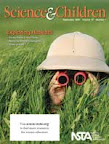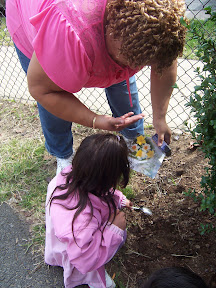Planting this fall for springtime blooms
By Peggy Ashbrook
Posted on 2009-08-29
I’m planning a fall gardening activity now, before school starts, and the first step is to mark my calendar to buy spring flowering bulbs before the end of September. Seasonal changes vary across the many climates in the United States. If you get temperatures below 40°F for extended periods of time, you can plant these bulbs too. If not, go to the Tag Cloud menu on the left and click on “Growing Plants” to see the September 15, 2008, post with a link to growing other types of bulbs.
 Read the activity about planting spring-flowering bulbs in the Early Years column in the September issue of Science and Children, the National Science Teachers Association’s elementary school journal.
Read the activity about planting spring-flowering bulbs in the Early Years column in the September issue of Science and Children, the National Science Teachers Association’s elementary school journal.
If all your students are years beyond the exploring-with-their-mouth stage then they can plant my favorite flower, daffodils or jonquils. If there is any chance that a student might bite into a bulb, buy Camassia spp. (also called Camas, Quamash, and Wild Hyacinth) bulbs which are a safe plant to eat (although I never have). Check out plant toxicity online using the lists for unsafe and safe plants at the California Poison Control System before making garden choices. And most importantly, know your students and be watchful.
 Sing a song before and after planting bulbs, and all winter long while wondering if the bulbs really will sprout.
Sing a song before and after planting bulbs, and all winter long while wondering if the bulbs really will sprout.
Act out the following song while you sing it, to the tune of the traditional song “Jack in the Box”.
Spring flowering bulb, (children curl face down on floor, hiding face)
So safe in the ground,
Way down inside, your little dirt mound, (hands curve over head)
Spring flowering bulb so quiet and still,
Won’t you sprout up? (heads up and jump up, stretch arms up high)
Of course I will!
Do you have a favorite book about planting flowering bulbs? Both non-fiction and fiction that ties into the science topic are useful. Here are some that have been successful in my classes:
- A Flower Grows by Ken Robbins. 1990. Dial Books.
The book follows the growth of an amaryllis bulb through photos.
- From Bulb to Daffodil by Ellen Weiss. 2007. Children’s Press (CT).
This excellent book includes plant structure details through photography and introduces some vocabulary so it can be useful for English language learners as well as early readers. I wish the book did not use the word “sleeping” instead of “leaf senescence” to describe the leaf and flower die-back because young children can learn, and like to use, big words that are more precise. “Senescence.” I clap and say it to help myself remember: sen-nes-ence, (sənes′-əns).
- The Life Cycle of a Flower by Molly Aloian and Bobbie Kalman. 2004. Crabtree Publishing Company.
Photographs reveal the details of flower structures and plant parts and the text describes seed production and other ways plants reproduce.
- Investigate Plants by Sue Barraclough. 2009. Heinemann Library.
With a question and answer format, this book asks readers to answer before turning the page.
- Planting a Rainbow by Lois Elhert. 1988. Harcourt Brace Jovanovich.
This classic shows bulbs in the ground before sprouting and when blooming.
What seasons do you experience? Do your students remember the way it rained and rained last spring or the big snow that happened as long as 1/4 their lifetime ago? Here are some books for discussing the cycle of seasons and the passage of time with young children:
- Boxes for Katje by Candace Fleming Candace Fleming and Stacey Dressen-McQueen. 2003. Farrar, Straus and Giroux.
This story about tough times in post World War II Holland is based on the experiences of the author’s mother who sent boxes to a family in Holland.
- Spring: An Alphabet Acrostic by Steven Schnur, illustrated by Leslie Evans. 1999. Clarion Books.
Spring from A to Z, each page an acrostic poem beginning with the letters of the alphabet. Your class may want to write their own acrostic poem about a word related to the season. The series includes Winter, Summer, and Autumn.
- What Comes in Spring by Barbara Horton, illustrated by Ed Young. 1992. Knopf.
In this story a mother relates the family’s milestones to the seasons.
- When This Box is Full by Patricia Lillie, illustrated by Donald Crews. 1993. Greenwillow Books.
Children love to guess what the girl will put in the box next to represent the month (one object per month). It reminds me of The Important Book by Margaret Wise Brown in that it says what is important to a child about a time of year. For me it would be ice, a heart, seeds, a kite, sunscreen, swimming pool, a novel, tomatoes, school supplies, birthday cake, pumpkins, and a candle. What would you and your class choose?
- A Year in the City by Kathy Henderson, illustrated by Paul Howard. 1996. McGraw-Hill.
Some seasonal changes are specific to urban environments: snow grey with car exhaust, Chinese New Year parades, and city park garden blooms.
Share the seasonal books you find useful by posting a comment below. Hope you get to plant with your class!
Peggy
Disclaimer: The views expressed in this blog post are those of the author(s) and do not necessarily reflect the official position of the National Science Teaching Association (NSTA).


